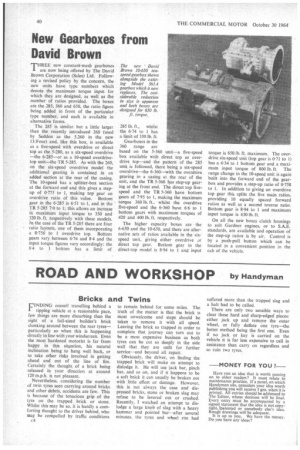ROAD AND WORKSHOP by Handyman
Page 42

If you've noticed an error in this article please click here to report it so we can fix it.
Bricks and Twins
FINDING oneself travelling behind a tipping vehicle at a reasonable pace, few things are more disturbing than the sight of a full-sized builder's brick clonking around between the rear tyres— particularly so when this is happening directly in line with your windscreen. Even the most hardened motorist is far from happy in this sitpation, his natural inclination being to hang well back, or to take other risks involved in getting ahead and out of the line of fire. Certainly the thought of a brick being released in your direction at around 120 m.p.h. is not pleasant.
Nevertheless, considering the number of twin tyres seen carrying around bricks and other debris, accidents are few. This is because of the tenacious grip of the tyre on the trapped brick or stone. Whilst this may be so, it is hardly a comforting thought to the driver behind, who may be compelled by traffic conditions (.4 to remain behind for some miles. Thetruth of the matter is that the brick is most unwelcome and steps should be taken to remove it with all speed. Leaving the brick so trapped in order to complete that journey can turn out to be a most expensive business as both tyres can be cut so deeply in the side wall that they are unfit for further service—and beyond all repair.
Obviously, the driver, on finding the trapped brick will make an attempt to dislodge it. He will use jack bar, pinch bar, and so on, and if it happens to be a soft brick it cats usually be broken out with little effort or damage. However, this is not always the case and diepressed bricks, stone or broken slag may refuse to be levered out or crushed. Recently, I watched an attempt to dislodge a large knob of slag with a heavy hammer and pointed bar—after several minutes, the tyres and wheel rim had suffered more than the trapped slag and a halt had to be called.
There are only two sensible ways to clear these hard and sharp-edged pieces: either jack up and remoye the outer wheel, or fully deflate one tyre—the better method being the first one. Even if no jack or key is carried on the vehicle it is far less expensive to call in assistance than carry on regardless and so ruin two tyres.












































































































